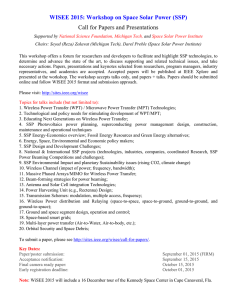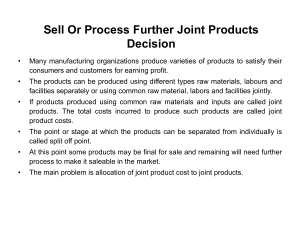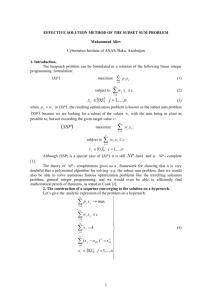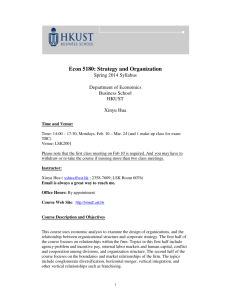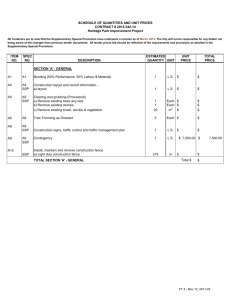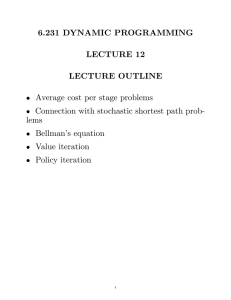Syllabus
advertisement
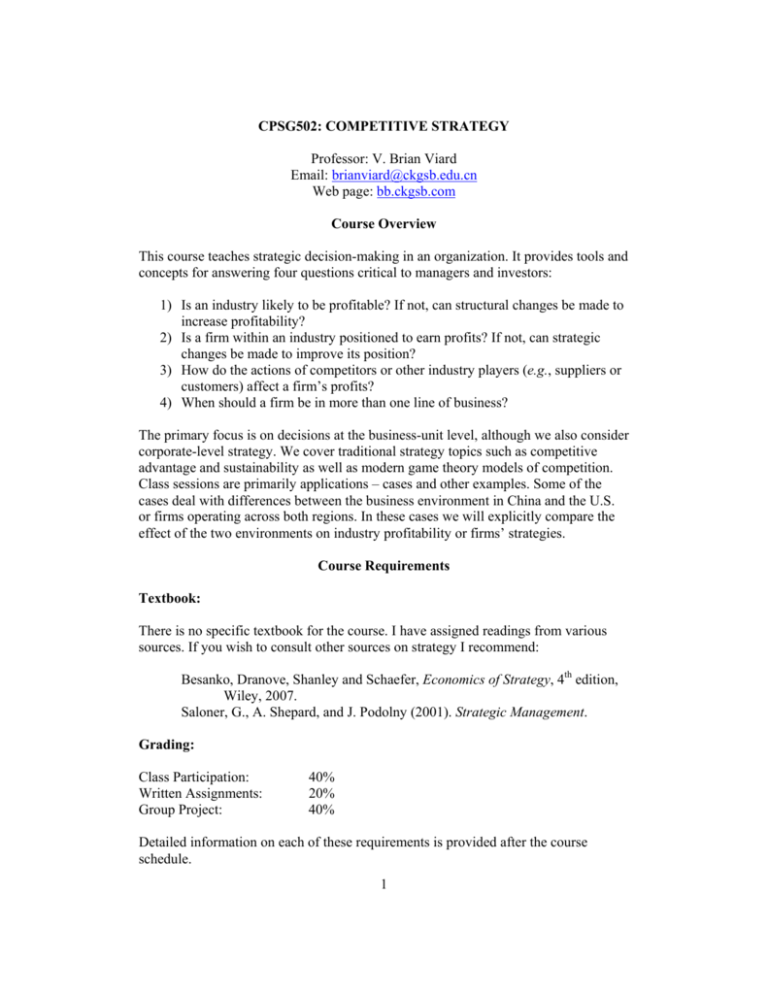
CPSG502: COMPETITIVE STRATEGY Professor: V. Brian Viard Email: brianviard@ckgsb.edu.cn Web page: bb.ckgsb.com Course Overview This course teaches strategic decision-making in an organization. It provides tools and concepts for answering four questions critical to managers and investors: 1) Is an industry likely to be profitable? If not, can structural changes be made to increase profitability? 2) Is a firm within an industry positioned to earn profits? If not, can strategic changes be made to improve its position? 3) How do the actions of competitors or other industry players (e.g., suppliers or customers) affect a firm’s profits? 4) When should a firm be in more than one line of business? The primary focus is on decisions at the business-unit level, although we also consider corporate-level strategy. We cover traditional strategy topics such as competitive advantage and sustainability as well as modern game theory models of competition. Class sessions are primarily applications – cases and other examples. Some of the cases deal with differences between the business environment in China and the U.S. or firms operating across both regions. In these cases we will explicitly compare the effect of the two environments on industry profitability or firms’ strategies. Course Requirements Textbook: There is no specific textbook for the course. I have assigned readings from various sources. If you wish to consult other sources on strategy I recommend: Besanko, Dranove, Shanley and Schaefer, Economics of Strategy, 4th edition, Wiley, 2007. Saloner, G., A. Shepard, and J. Podolny (2001). Strategic Management. Grading: Class Participation: Written Assignments: Group Project: 40% 20% 40% Detailed information on each of these requirements is provided after the course schedule. 1 Course Schedule I. BUSINESS-UNIT LEVEL Topic 1: Strategy Identification and Evaluation Reading: SSP,1 pages 19 – 23. Case: Wal-Mart Stores, Inc., HBS Case 9-794-024 (pages 1 – 10). Topic 2: Competitive Advantage Reading: SSP, pages 39 – 53. Case: Wal-Mart Stores, Inc., HBS Case 9-794-024 (pages 11 – 15). Wal-Mart in China, Harvard-Asia Pacific Review, Winter 2007, Vol. 9. No. 1, 46 – 49. II. INDUSTRY LEVEL Topic 3: Strategic Interaction Reading: BDSS,2 pages 208 – 215. Case: Shrimp Game. Topic 4: Industry Analysis Reading: SSP, pages 127 – 144. Case: Cola Wars Continue: Coke and Pepsi in 2006, HBS Case 9-706-447 (pages 1 – 9). Topic 5: The Value Chain and Strategy Transferability Reading: SSP, pages 244 – 255. Case: Cola Wars Continue: Coke and Pepsi in 2006, HBS Case 9-706-447 (pages 9 – 15). The Battle for China’s Carbonated Beverage Industry, CKGSB Case 2012-02-1-232-2. 1 SSP refers to Saloner, Shepard and Podolny, Strategic Management. “BDSS” refers to Besanko, Dranove, Shanley and Schaefer, Economics of Strategy, 4th edition, Wiley, 2007. 2 2 III. CORPORATE LEVEL Topic 6: Horizontal and Vertical Scope (Diversification) Reading: BDSS, pages 166 – 173. Case: BitAuto, CKGSB Case (to be distributed). Topic 7: Strategy with Network Effects & Incomplete Information Reading: SSP, pages 305 – 315. Mankiw, N. G., Principles of Economics, pages 484 – 490. Case: Baidu: Searching for Truth, CKGSB Case 2010-09-1-177-2e. Topic 8: Project Presentations Evaluation Class Participation: (individual) You are responsible for preparing to discuss each case. I will “cold call” students to discuss the case, but will also seek volunteers to speak. Quality of class participation is more important than quantity. Consider the following questions when assessing the quality of your participation: 1. Are the points relevant to the discussion? Are they linked to the comments of others and to the ideas of the class? Do the comments move the discussion forward rather than backward? 2. Do the comments make an argument rather than an isolated comment? The former are more valuable than the latter. 3. Do the comments help us understand the issues in the case? Citing case facts to support an argument is useful but avoid simply repeating case facts without making an argument. 4. Do the points challenge, in a constructive way, the ideas that others are expressing? Such points are particularly valuable. Preparation for a case study involves more than just having read the case. You should be prepared to offer original and thoughtful analysis in which your claims are supported by evidence, logic, and possibly calculations. Many students find it helpful – and I encourage you – to discuss the case with your classmates prior to the class. The most effective way to prepare for class is to try to answer the preparation questions for each class after you have read the readings and the case. 3 Because a case-oriented course relies on class participation for its success, attendance at every class is extremely important. Students who miss class will not receive class participation credit for that class. I do not allow or require “make-up” work for a missed class. If you must miss class, most handouts will be available at the class website. Written Assignments: (groups) There will be two written assignments for the class. These will be related to preparation for your final group presentation. The first assignment will be due on May 16. If you choose Option 1) below this should define the industry and its substitute products or services. If you choose Option 2) below this should identify the firm, its industry, and the major competitors. The second assignment will be due on May 23 and will contain all the necessary background information for your presentation. Group Project: (groups) The project will ask your group to apply the concepts from the class to an actual firm or industry. There are two alternative types of projects that your group can pursue and you should choose only one of these approaches: 1) Choose an industry in which you are interested and answer the question: Will this industry be unprofitable, moderately profitable, or very profitable over the long run? If you choose this type of project, think about both of the following: a. You are managing a pool of money and deciding how to allocate longterm investments across industries. Would this be an attractive industry in which to invest or not? b. You are a consultant advising one of the incumbent firms. Is there anything you would recommend that the firm do to improve industry profitability? 2) Choose a company (this could be a start-up idea) in which you are interested and answer the question: Will this firm be unprofitable, moderately profitable, or very profitable over the long run? If you choose this type of project, think about both of the following: a. You are managing a pool of money and deciding how to allocate longterm investments across firms. Would this be an attractive firm in which to invest or not. b. You are the CEO of the company. Is there anything you can do to improve the firm’s long-run profitability? You should choose an industry for option 1 (or a firm for option 2) that interests your group. If you choose option 2) it is best to choose a firm that has relatively few major competitors (four or fewer) to keep things manageable. If you have contacts in a firm or industry it is useful to work with them in your project, however this is not necessary. Your project can be based entirely on publicly available information. The final output of the project is a presentation during the last class. This presentation will consist entirely of analysis – no background information. I will have all the 4 background information from your written assignments (see above). Research on the details is essential, but the key to a successful project is to analyze, not just describe. If you have any doubts about your topic, please talk to me. If you are thinking of an industry or firm featured in a case that has been used in a course at CKGSB you must talk to me first. Similarly, if you are thinking of presenting on a topic that is related to a project or paper for another course at CKGSB you must talk to me first. Honor Code Issues My goal is that each individual student gains valuable learning through this course. Since some of the assignments in this course are accomplished in groups, here is my policy on group work for my class: 1. I encourage you to discuss the cases in preparing for class with any student. However, I expect you to present in class case analyses that you personally participated in preparing. 2. For the written assignments and group project, it is important that you demonstrate how well you and your group members understand the course concepts. For this reason, do not consult with students outside of your group for these. 5



